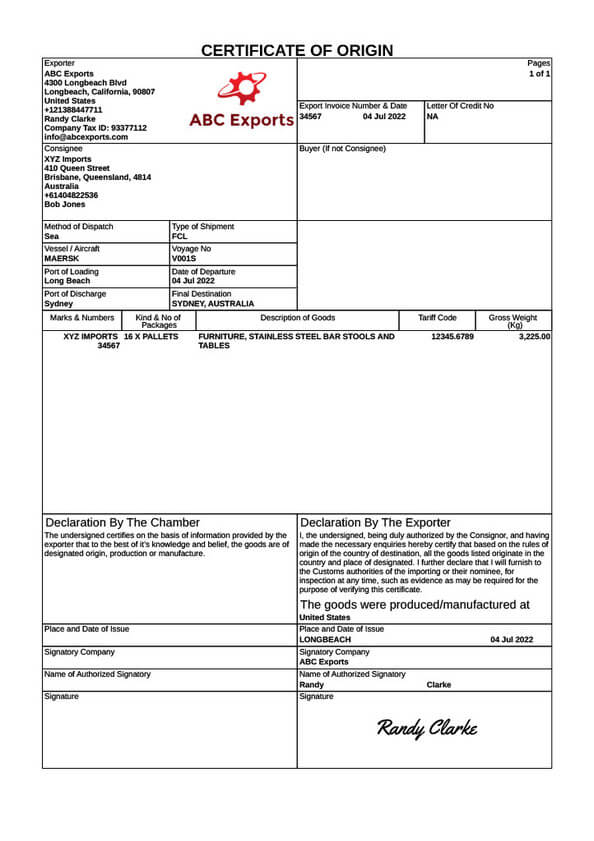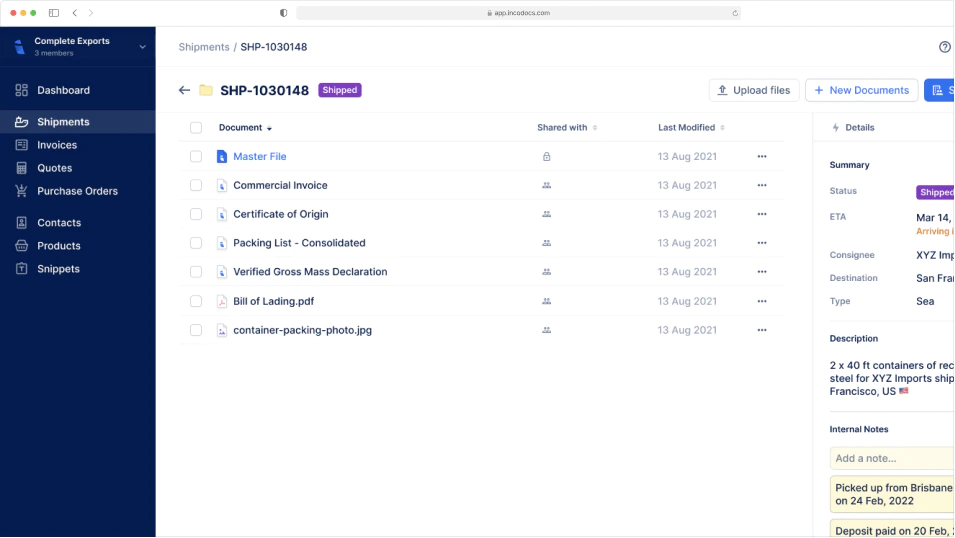IncoDocs raises $1.2M seed round led by Maersk GrowthRead the announcement

Certificate of Origin Template
What is a Certificate of Origin used for?
The purpose of a Certificate of Origin is to prove where goods were manufactured. It allows customs to check if a shipment qualifies for preferential tariff treatment or if import restrictions apply. This document is used by freight forwarders, customs brokers, and border officials during clearance. It helps verify that the goods meet trade agreement rules set by the destination country. Some banks may also request a certified copy before releasing payment under a letter of credit. To avoid delays or higher tariffs, the certificate must be filled out correctly and approved by an authorised body.
How to create a Certificate of Origin
Open IncoDocs
Open IncoDocs in your browser and navigate to the “Export Docs” section.
Choose the Certificate of Origin template
Click on 'New document set' and select the Certificate of Origin template along with any other export documents you wish to create.
Fill out & customize your doc
Fill out the document, customize template fields to your needs and add your company letterhead. To save time and prevent re-entry errors, enter key shipment data into the Master File to have it sync across all other documents in your set automatically.
Sign & seal
Click on the signature box at the bottom of your document to create and place a digital signature then hit “Save & Quit”. On the document preview screen, click on the ‘More’ dropdown button and select “Add company seal” to place a digital stamp.
Download or share
Download or share documents from IncoDocs in 1-click. Documents can be downloaded as PDF or CSV which can be imported into other systems without manual re-entry.
Your questions, answered.
How to obtain a Certificate of Origin from a Chamber of Commerce
Most countries have a Chamber of Commerce that issues Certificates of Origin. Exporters fill out the CO form and send it to their local chamber. Some chambers still use paper forms with stamps and signatures. Others provide a digital PDF certificate online.
When treaty agreements exist between exporting and importing countries, the CO must meet specific origin rules. For example, under USMCA you submit a USMCA Certificate of Origin to an American Chamber of Commerce when exporting from the U.S. to Canada.
Examples of Chambers that issue Certificates of Origin:
What information is included on a Certificate of Origin Document?
A Declaration Of Origin or Certificate of Origin form will include the below details:
Can I import without Certificate of Origin?
Yes, goods can be imported without a Certification of Origin. But without it, customs cannot determine where the goods originate. This matters when a trade agreement is in place between the exporting and importing countries. These agreements often lower or remove tariffs for goods that meet origin rules.
If you don’t provide the certification, your goods will be treated as standard imports. You’ll need to pay full duty rates, even if they could qualify for reduced or zero tariffs under a trade deal.
Who provides and signs the Certification of Origin?
The Certification of Origin is usually created by the exporter. In some cases, the manufacturer may prepare it if they hold all the shipment details. The person or business that issues the certificate must confirm that the goods originate from the stated country.
The exporter or an authorized representative signs this form. If a third party handles the export, such as a freight forwarder or customs agent, they may complete and sign it with written permission. The final certificate is then submitted to a chamber of commerce or authorized body for verification.
Can a Certificate of Origin be amended after submission?
Yes, it’s possible to make changes after a Certificate of Origin has been issued. Contact the chamber of commerce or certifying body that approved the original. You’ll need to submit the incorrect certificate, a corrected version, and a short written explanation.
You may also be asked to provide the original commercial invoice, packing list, or export declaration to confirm the correction. The issuing body will check if the new details are valid. If approved, they will reissue the certificate.
Any changes must follow the rules of the importing country and match the trade agreement used to determine origin. If the correction affects the origin status, updated documents may be needed to confirm eligibility.
What are the common mistakes when filling out the Certificate of Origin
Carefully review each section before submitting. Small errors can lead to big delays or extra charges at the border.
What types of products require a Certificate of origin?
The need for a Certificate of Origin depends on the type of goods, the destination country, and the trade agreement in place. Some products must be certified to access reduced tariffs or meet import requirements. Exporters should always check if their goods need this certification, as it can impact duty rates, customs approval, and compliance with trade laws.
Is this Certificate of Origin template free?
Yes, IncoDocs offers a free Certificate of Origin template. You can sign up for a free account to access the fillable PDF version. This ensures you can complete, download the file, and reuse the document easily alongside other export forms.
Free to start,
Easy to use.
Setup in 5 mins.
